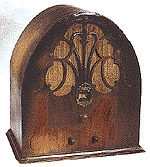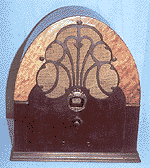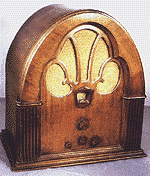|
|
• RADIO SURVEY RESULTS • | |||
| Parts 1 and 2 - Early Philco Models |
||||
Radio Survey Results Part 1 - Models 20 & 21Excerpted from the July, 1994 issue of Antique Radio Classified by permission of the authors and ARC.© Copyright 1993, 1994, 1995 ARC, Ron Boucher and Ron Ramirez. Charts and graphs © Copyright 1994, Ron Boucher.
The goal of this survey was to gather enough data on the early Philco cathedrals to determine when various versions and features were introduced. What made
this study possible was the fact that Philco often stamped dates of manufacture under the early cathedral cabinets. About 44 percent of the radios in this report had dates.
The survey data enabled us to produce a graph whereby the approximate date of manufacture could be determined from a serial number. The graph appears [below] as Figure 1. Only radios with serial numbers and dates were used for this graph. The circles indicate individual data points, and the solid line is
our best guess as to where most of the radios would fall. There are several data points that are way off this line. We believe these to be mismatched cabinet/chassis combinations. It's possible that these were the result of a cabinet or chassis being taken off the assembly line and sent back for repair. A match up of cabinet and chassis known to be not original was not included in this graph.
Figure 2 includes all the serial numbers we have surveyed [as of July 94]. Each radio is represented by a small circle. Serial numbers were issued throughout the model year, and where there is a high concentration of circles, we can say that there were many of these serial numbers being assigned to Model 20. Where there are few circles, we can say that Philco was concentrating on producing other models. For more detailed analysis and commentary, please refer to the original July, 1994 ARC article and Part 3 of the series in the July, 1995 ARC.
Radio Survey Results Part 2 - Models 70, 570, 35, 90, 90X, 50, 51by Ron Boucher and Ron RamirezExerpted from the May, 1995 issue of Antique Radio Classified by permission of the authors and ARC. Charts and graphs ©1994, Ron Boucher
This second report in the series covers the Models 50 and 35 (battery versions of the 70), 51, 70, 90, and the grandfather clock radio, Model 570. Models 70 and 90 are shown below.
The goal was to gather and present this information in such a way as to make it possible to estimate closely the date of manufacture of any given radio by simply knowing the serial number. Many design changes were made throughout the production of these sets, and we hoped to pin down when these changes were made.
Figures 3 and 4 are the graphs that were produced using the data from this survey. The first graph (Figure 3 below) shows the relationship of chassis serial numbers to dates stamped under the cabinet. It wasn't necessary to produce a separate graph for each model because there was one serial number series for all models.
By leaving out five radios that were obvious mismatches, we were able to obtain a graph that showed a nice correlation between cabinet dates and serial numbers. Figure 3 includes about 50 radios [as of May 95], and in some areas there is such a high concentration or data points that it's hard to distinguish
individual radios.
Figure 4 includes all the survey responses and shows the serial number grouping for Models 50, 70, and 90. We acquired data from almost 170 radios or about .03 percent of the total made. Even with this small sampling, we can see evidence that the numbers were issued for various model in batches. Usually where there is a group of model 70s, for example, there will be no Model 90s.
There were two exceptions in which there was a Model 90 tucked in with a group of Model 70s. One is in the 168000 range when Philco was first introducing these new models to the public. Another is in the B35000 range when the company was starting to make the first Type 3 Model 90s. For more detailed analysis
and individual model characteristics, please refer to the original May, 1995 ARC article.
To contact ARC or
the authors:
Antique Radio Classified, P.O Box 2, Carlisle, MA 01741 - Web: Antique Radio Classified Ron Boucher - Email: ronboucher@attbi.com Ron Ramirez - Website: www.philcoradio.com/contact.htm
|
||||









